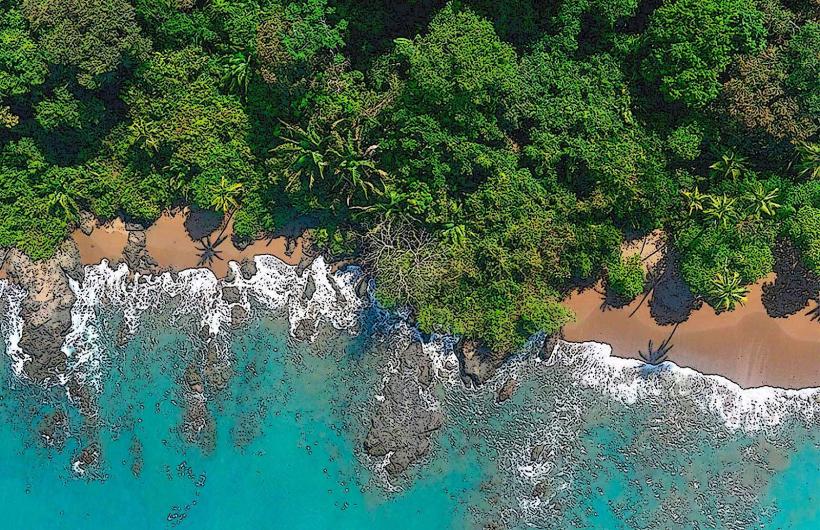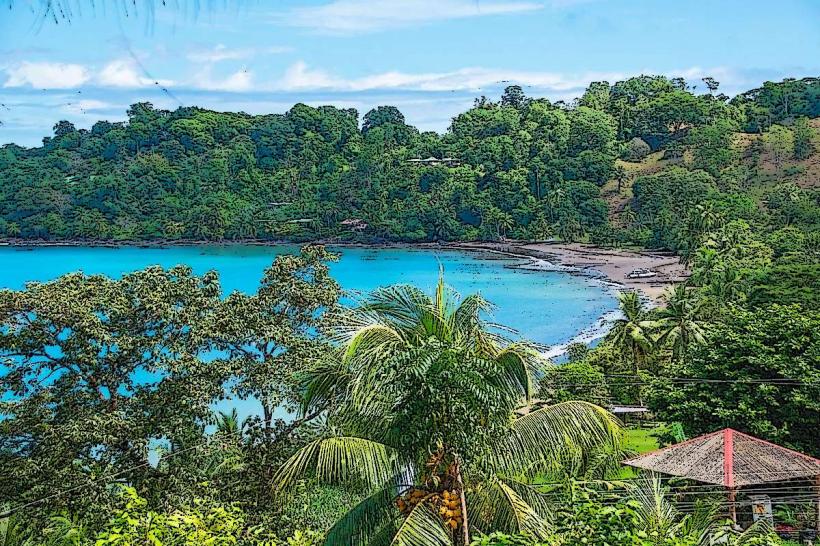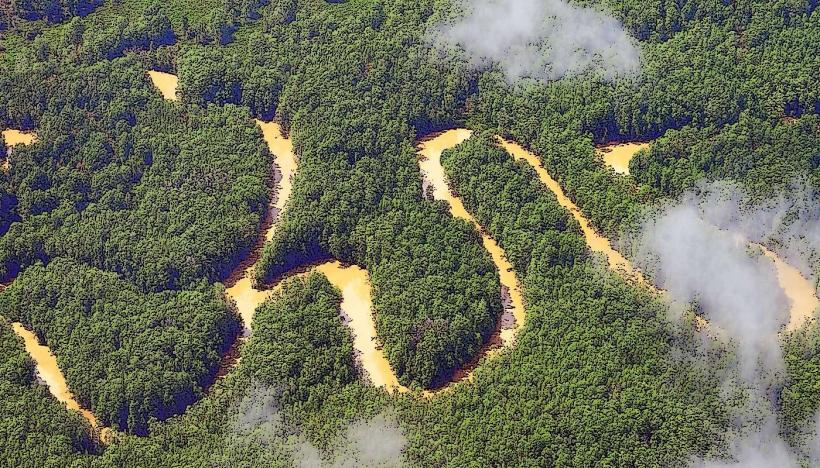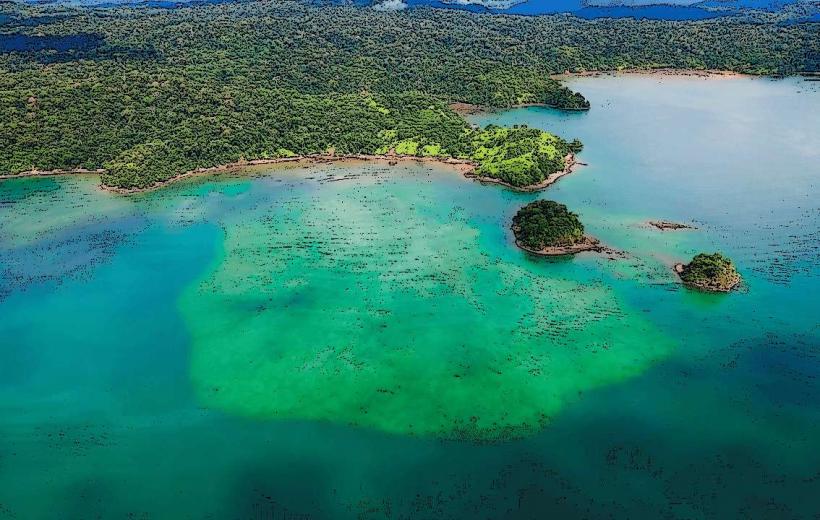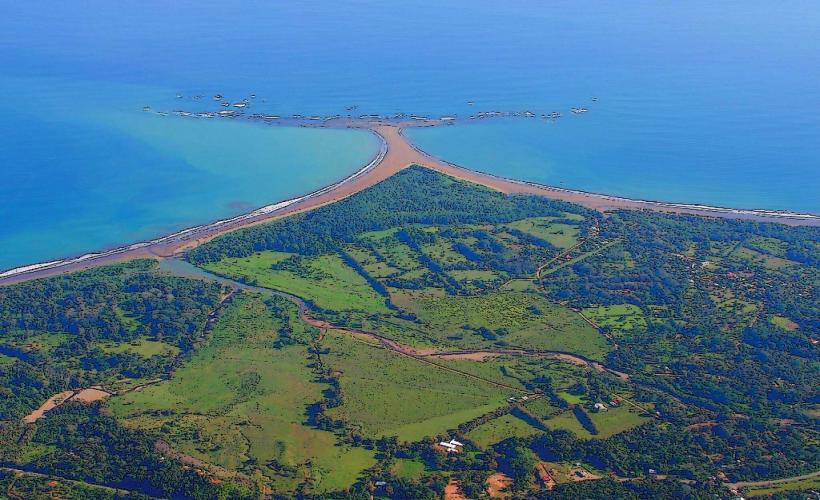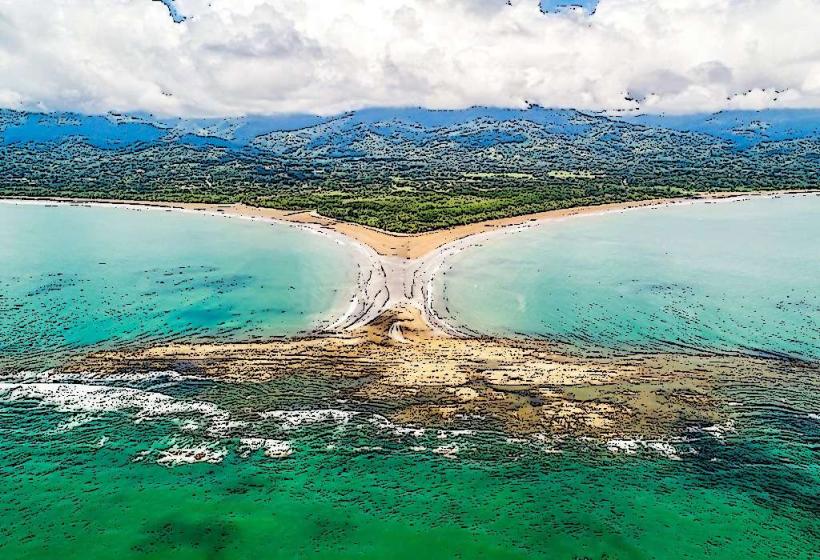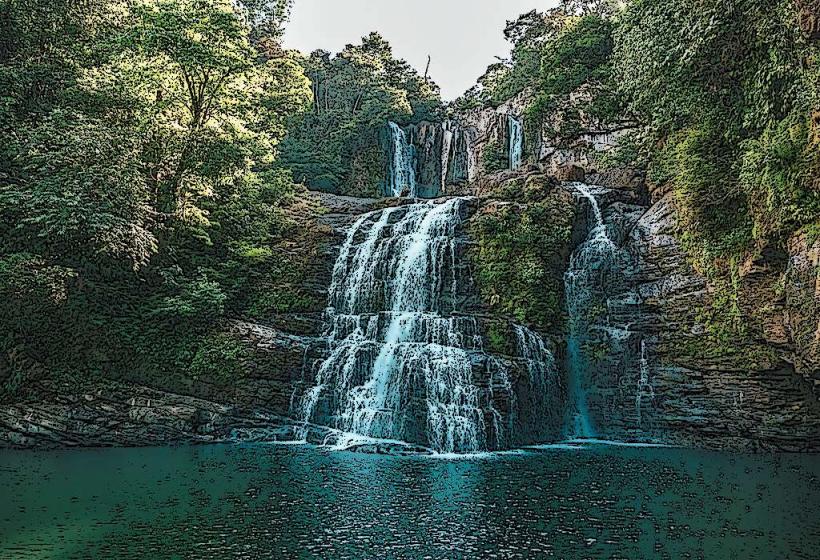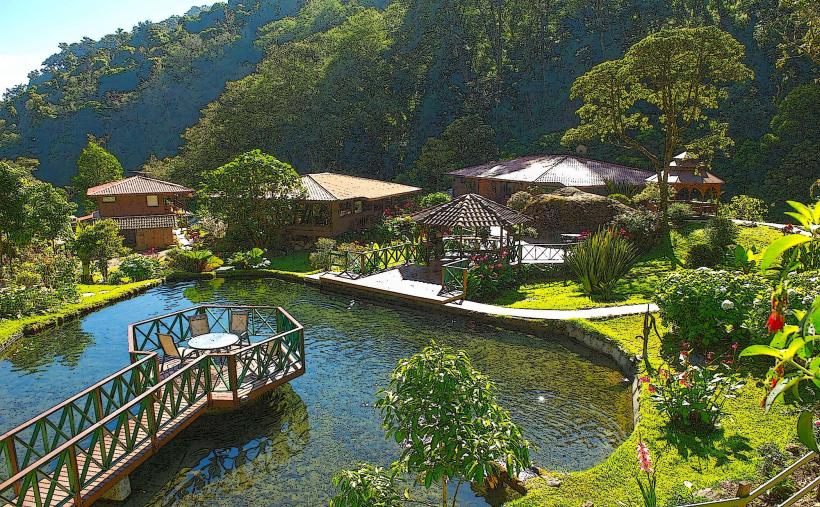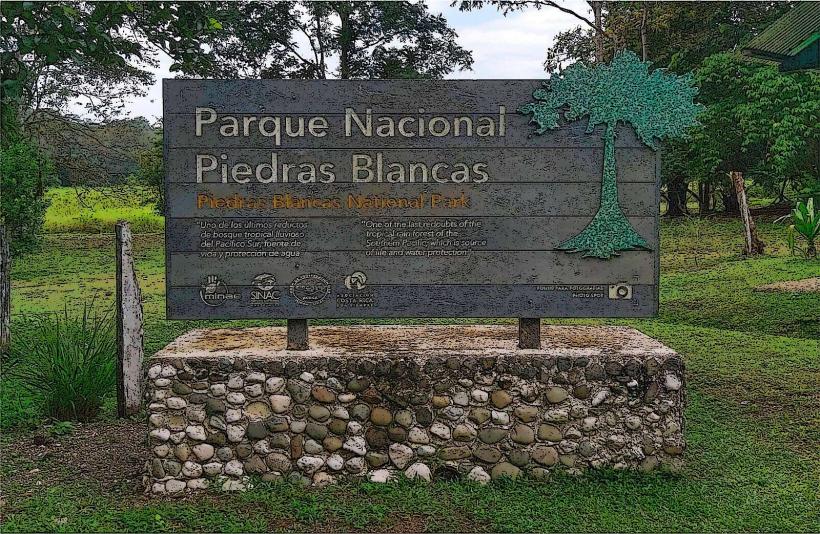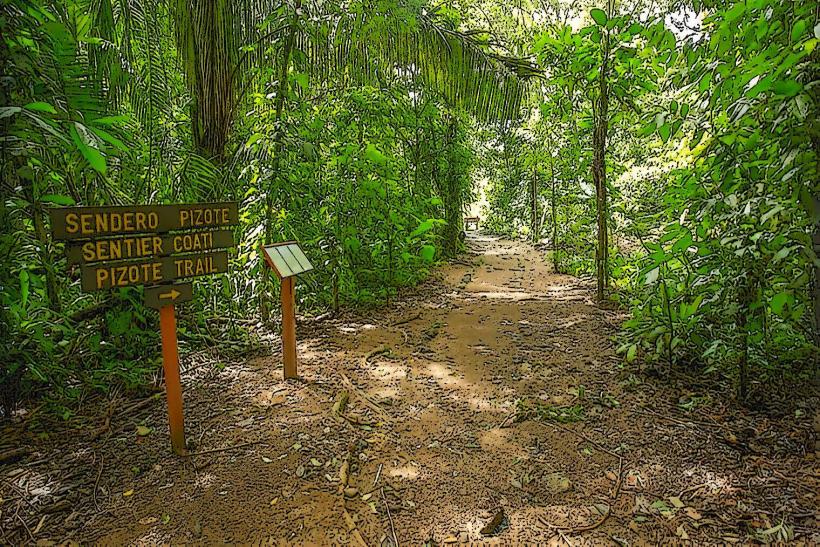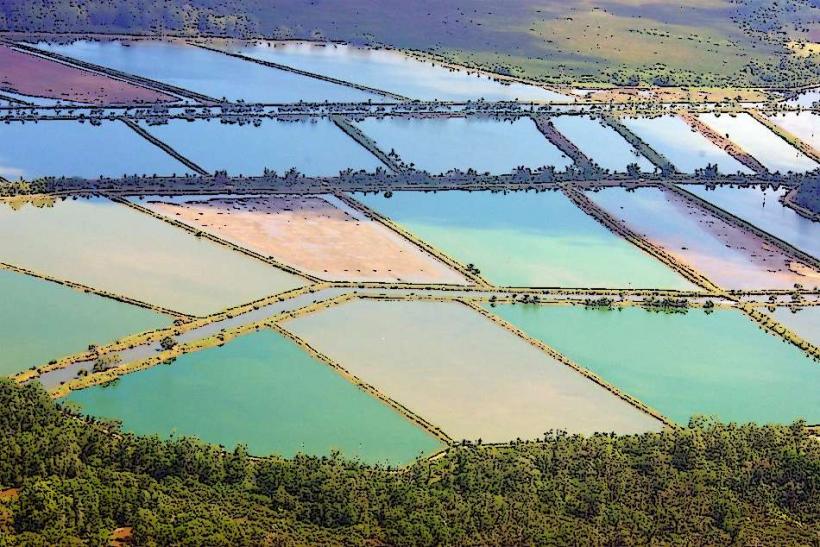Information
Landmark: Whale’s Tail BeachCity: Zona Sur
Country: Costa Rica
Continent: North America
Whale's Tail Beach (Playa Cola de Ballena) is an iconic beach located in Marino Ballena National Park in Uvita, Costa Rica. The beach is famous for its unique shape, which resembles the tail of a whale. This distinctive sandbar formation is created by a crescent-shaped sandbar that is visible at low tide, forming a natural "whale’s tail" that extends into the ocean. This striking formation is one of the most recognized features of the region and is a symbol of the park’s focus on whale conservation.
Geography and Location
- Location: Whale’s Tail Beach is located in Uvita, on the southern Pacific coast of Costa Rica, within Marino Ballena National Park, a protected area dedicated to the conservation of marine life.
- Whale Tail Formation: The beach gets its name from the whale-tail shaped sandbar that extends into the Pacific Ocean. The formation is most visible at low tide, creating a dramatic and picturesque scene.
- Access: The beach is easily accessible by foot from the park's entrance. It can also be viewed from nearby lookout points along the park's trails.
Ecological Importance
Whale’s Tail Beach is located within Marino Ballena National Park, a significant marine conservation area in Costa Rica. The park is known for its whale watching, and the beach and surrounding waters provide critical habitat for migrating humpback whales, sea turtles, and many marine species.
Whale Watching:
- The Whale Tail sandbar is a crucial part of the park’s whale sanctuary. During the whale migration seasons (from December to April and August to November), the area becomes an ideal location for observing humpback whales and other marine mammals, such as dolphins.
- The whale watching season attracts visitors from around the world who come to see these majestic creatures up close, with boat tours departing from Uvita and the surrounding areas.
Marine Ecosystems:
- The waters surrounding Whale’s Tail Beach are home to vibrant coral reefs, seagrass beds, and mangrove ecosystems, all of which support a diverse range of marine life. These ecosystems are essential for the survival of species like sea turtles, rays, and various fish species.
Turtle Nesting:
- Whale’s Tail Beach is a lesser-known nesting site for olive ridley and hawksbill turtles. Though the area does not experience the same volume of nesting as beaches on the Caribbean coast, it still plays a significant role in turtle conservation efforts.
Activities at Whale’s Tail Beach
- Whale Watching:
- As one of the main attractions of the Marino Ballena National Park, whale watching is a highlight at Whale’s Tail Beach. Boat tours operate during the migration seasons, offering a chance to observe humpback whales breaching, tail-slapping, and engaging in other behaviors.
- Snorkeling and Scuba Diving:
- The area around Whale’s Tail Beach features vibrant marine ecosystems, including coral reefs and underwater rock formations. Snorkelers can explore these habitats to see a variety of marine life, such as tropical fish, moray eels, and sea turtles. There are also diving trips available for those who want to explore the deeper waters.
- Kayaking and Paddleboarding:
- Kayaking and stand-up paddleboarding are popular activities at Whale’s Tail Beach. Visitors can paddle through the calm waters, exploring the coastline, mangrove forests, and the stunning whale-tail sandbar. This activity also provides a chance to spot dolphins and other marine animals.
- Beach Relaxation:
- Whale’s Tail Beach is an ideal spot for visitors who wish to relax and take in the surrounding beauty. The beach is spacious, with golden sand and surrounded by lush forests and mountainous backdrops. It is much less crowded than some of Costa Rica's other beaches, offering a peaceful and serene environment.
- Hiking and Exploring:
- For those who want to explore more of the park, there are hiking trails that lead to viewpoints overlooking Whale’s Tail Beach and the surrounding coastline. These trails offer opportunities for wildlife sightings, including monkeys, birds, and other tropical creatures.
Conservation and Environmental Significance
Whale’s Tail Beach is part of Marino Ballena National Park, which plays a key role in marine conservation in Costa Rica. The park is dedicated to the protection of whales, sea turtles, and marine ecosystems, making it one of the country’s most important marine sanctuaries.
Whale Conservation:
- The park serves as a whale sanctuary, protecting migrating humpback whales and other cetaceans. During their migrations, whales use the sheltered waters near Whale’s Tail Beach as a place to breed and give birth, making it an essential area for their survival.
Marine Ecosystem Protection:
- The surrounding waters are also protected as part of the national park, ensuring that coral reefs, seagrass beds, and mangrove forests are preserved. These ecosystems provide critical habitat for marine species and help maintain the overall health of the ocean.
Eco-Tourism:
- The park promotes eco-tourism, with a focus on sustainable travel that benefits both the local community and the environment. Entrance fees and guided tours help fund conservation efforts, allowing the park to continue protecting its marine and terrestrial ecosystems.
Practical Information
Best Time to Visit:
- The best time to visit Whale’s Tail Beach is during the dry season, which typically lasts from December to April. This period offers ideal weather conditions for beach activities, whale watching, and outdoor exploration.
- The whale watching season is most active between January and March, although you can still spot whales during the migration months of December to April and August to November.
How to Get There:
- Whale’s Tail Beach is located in Uvita, and visitors can access it from the Costanera Sur Highway (Route 34). From the highway, the beach is accessible by a short walk through the park.
- The town of Uvita is about a 3-4 hour drive from San José, the capital of Costa Rica, or about 30 minutes from Dominical.
Entrance Fees:
- To access Marino Ballena National Park and its beaches, including Whale’s Tail Beach, visitors must pay an entrance fee. This fee helps fund the park’s conservation efforts.
Accommodations:
- There are various accommodations available in and around Uvita, ranging from budget options to more luxurious eco-lodges and resorts. Many accommodations in the area focus on sustainability and offer guided tours to the park and surrounding attractions.
Conclusion
Whale’s Tail Beach is a must-see destination for nature lovers and eco-tourists visiting Costa Rica. Its unique whale-tail-shaped sandbar, along with its prime location within Marino Ballena National Park, makes it one of the country’s most picturesque and ecologically significant beaches. Whether you’re interested in whale watching, snorkeling, or simply relaxing on a pristine beach, Whale’s Tail Beach offers a stunning environment to experience Costa Rica’s natural beauty.

